fuse box TOYOTA COROLLA CROSS HYBRID 2023 Owners Manual
[x] Cancel search | Manufacturer: TOYOTA, Model Year: 2023, Model line: COROLLA CROSS HYBRID, Model: TOYOTA COROLLA CROSS HYBRID 2023Pages: 516, PDF Size: 15.96 MB
Page 350 of 516
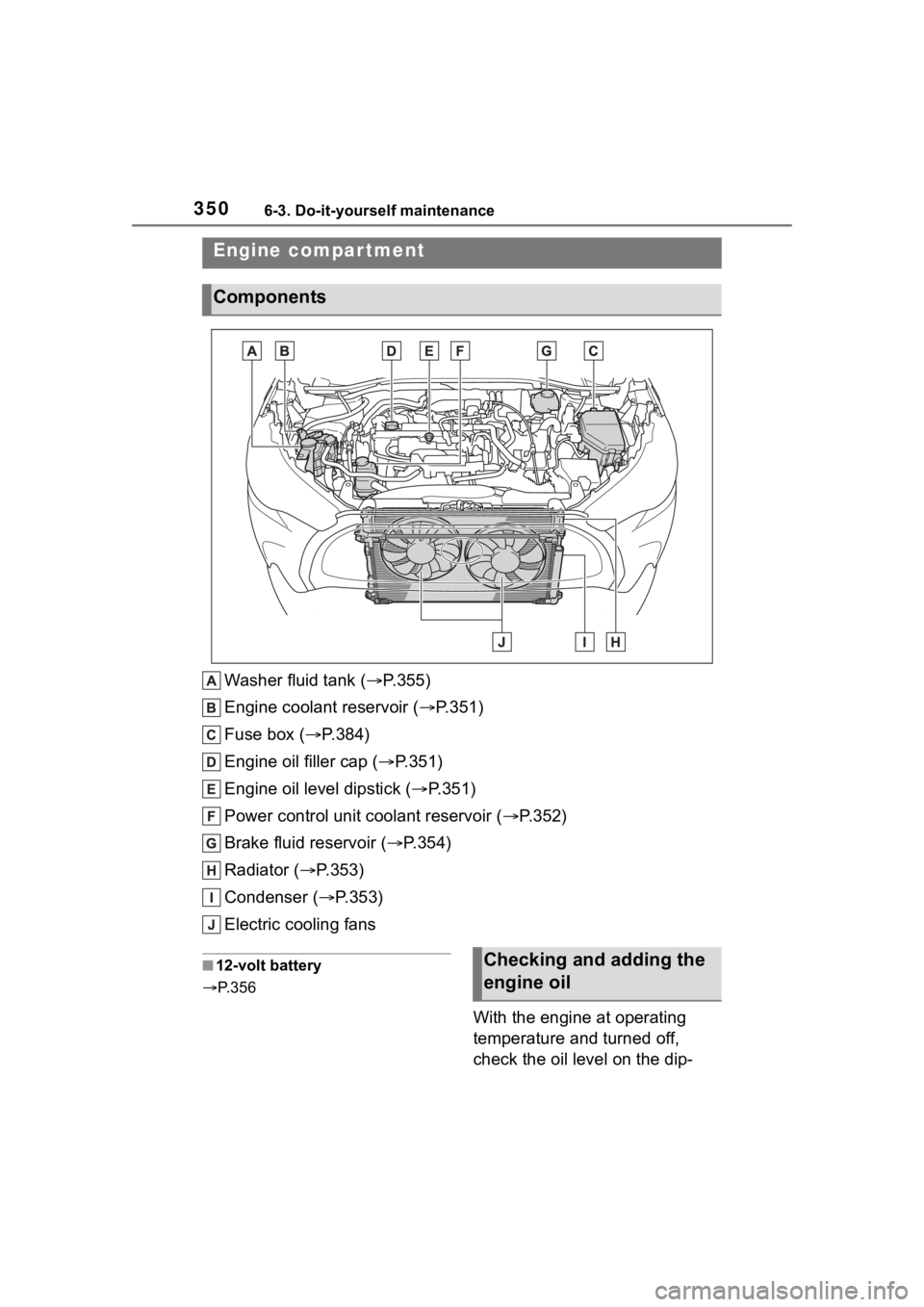
3506-3. Do-it-yourself maintenance
Washer fluid tank ( P.355)
Engine coolant reservoir ( P.351)
Fuse box ( P.384)
Engine oil filler cap ( P.351)
Engine oil level dipstick ( P.351)
Power control unit coolant reservoir ( P.352)
Brake fluid reservoir ( P.354)
Radiator ( P.353)
Condenser ( P.353)
Electric cooling fans
■12-volt battery
P. 3 5 6
With the engine at operating
temperature and turned off,
check the oil level on the dip-
Engine compar tment
Components
Checking and adding the
engine oil
Page 384 of 516

3846-3. Do-it-yourself maintenance
1Turn the power switch off.
2 Open the fuse box cover.
Engine compartment
Push the tabs in and lift the lid off.
Under the driver’s side instru-
ment panel
Remove the lid.
Make sure to push the claw when
removing/installing the lid.
WARNING
●If you accidentally swallow a
battery or put a b attery into a
part of your body, get emer-
gency medical attention imme-
diately.
■To prevent battery explosion
or leakage of flammable liq-
uid or gas
●Replace the battery with a new
battery of the same type. If a
wrong type of battery is used, it
may explode.
●Do not expose batteries to
extremely low pressure due to
high altitude or extremely high
temperatures.
●Do not burn, bre ak or cut a bat-
tery.
NOTICE
■When replacing the battery
Use a flathead screwdriver of
appropriate size. Applying exces-
sive force may deform or damage
the cover.
■For normal operation after
replacing the battery
Observe the following precautions
to prevent accidents:
●Always work with dry hands.
Moisture may cau se the battery
to rust.
●Do not touch or move any other
component inside the remote
control.
●Do not bend either of the battery
terminals.
Checking a nd replac-
ing fuses
If any of the electrical com-
ponents do not operate, a
fuse may have blown. If this
happens, check and replace
the fuses as necessary.
Checking and replacing
fuses
Page 385 of 516
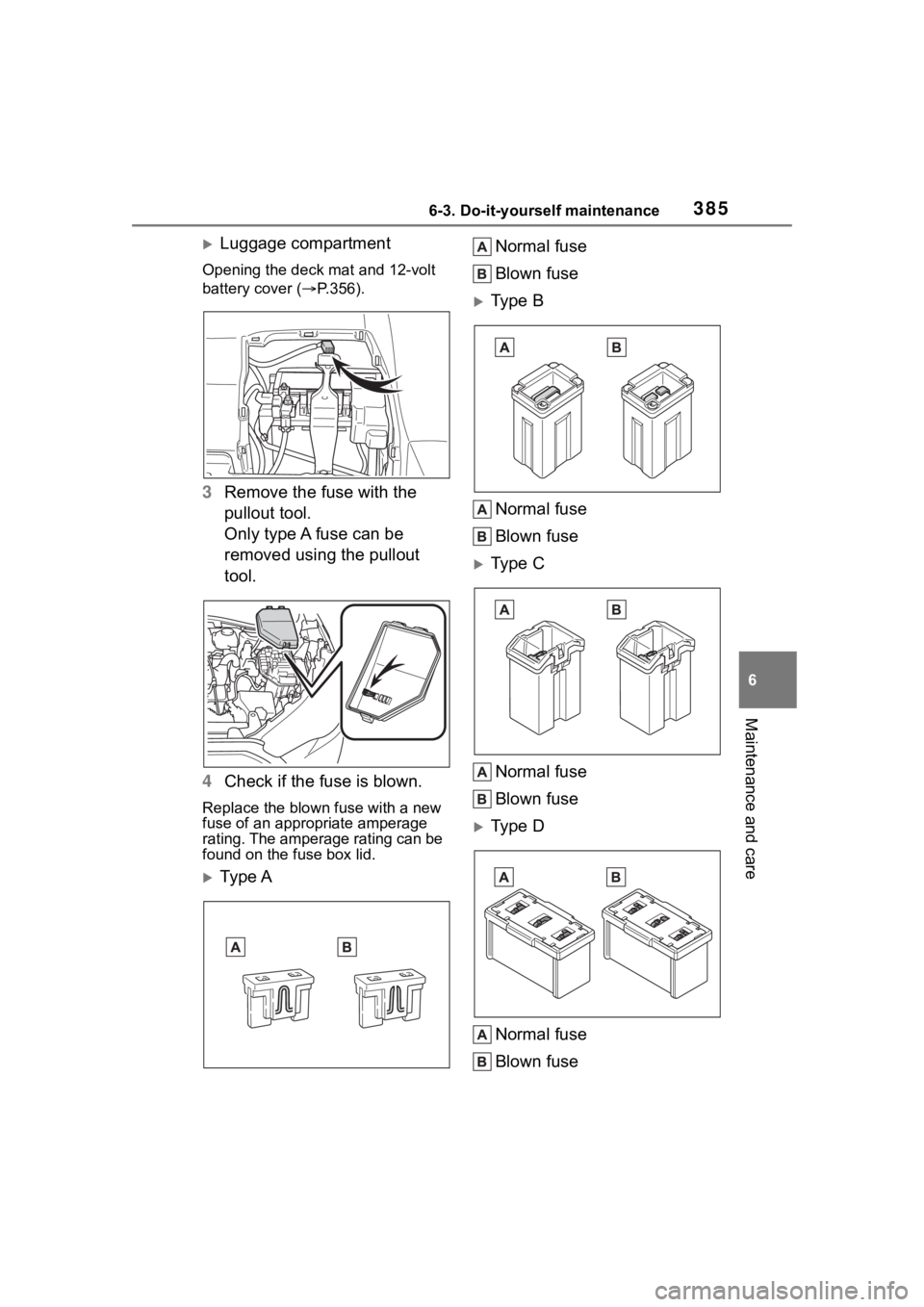
3856-3. Do-it-yourself maintenance
6
Maintenance and care
Luggage compartment
Opening the deck mat and 12-volt
battery cover (P.356).
3 Remove the fuse with the
pullout tool.
Only type A fuse can be
removed using the pullout
tool.
4 Check if the fuse is blown.
Replace the blown fuse with a new
fuse of an appropriate amperage
rating. The amperage rating can be
found on the fuse box lid.
Ty p e A Normal fuse
Blown fuse
Type B
Normal fuse
Blown fuse
Type CNormal fuse
Blown fuse
Type D
Normal fuse
Blown fuse
Page 386 of 516
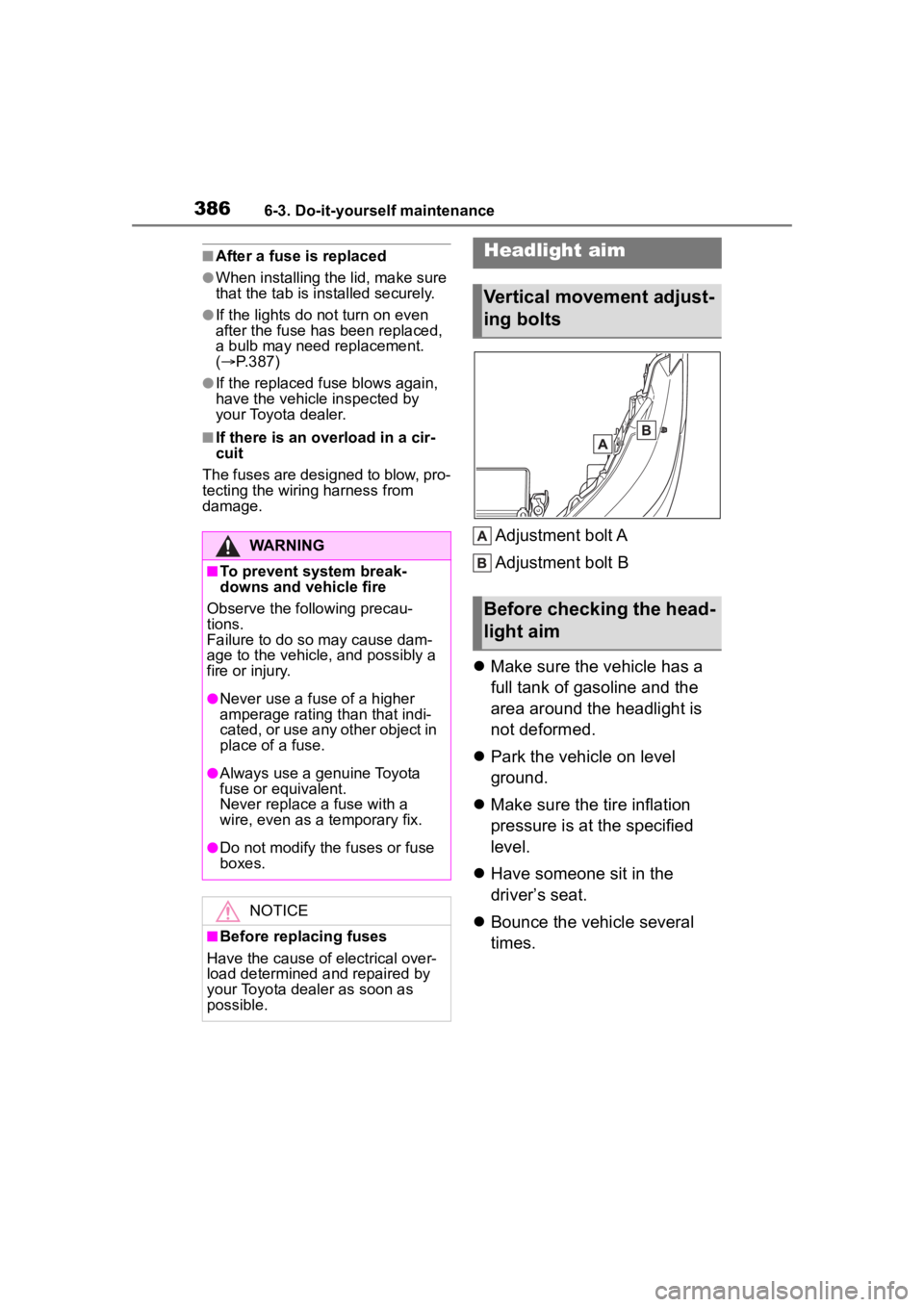
3866-3. Do-it-yourself maintenance
■After a fuse is replaced
●When installing the lid, make sure
that the tab is installed securely.
●If the lights do not turn on even
after the fuse has been replaced,
a bulb may need replacement.
( P.387)
●If the replaced fuse blows again,
have the vehicle inspected by
your Toyota dealer.
■If there is an overload in a cir-
cuit
The fuses are designed to blow, pro-
tecting the wiring harness from
damage.
Adjustment bolt A
Adjustment bolt B
Make sure the vehicle has a
full tank of gasoline and the
area around the headlight is
not deformed.
Park the vehicle on level
ground.
Make sure the tire inflation
pressure is at the specified
level.
Have someone sit in the
driver’s seat.
Bounce the vehicle several
times.WARNING
■To prevent system break-
downs and vehicle fire
Observe the following precau-
tions.
Failure to do so may cause dam-
age to the vehicle, and possibly a
fire or injury.
●Never use a fuse of a higher
amperage rating than that indi-
cated, or use any other object in
place of a fuse.
●Always use a genuine Toyota
fuse or equivalent.
Never replace a fuse with a
wire, even as a temporary fix.
●Do not modify the fuses or fuse
boxes.
NOTICE
■Before replacing fuses
Have the cause of electrical over-
load determined and repaired by
your Toyota dealer as soon as
possible.
Headlight aim
Vertical movement adjust-
ing bolts
Before checking the head-
light aim
Page 433 of 516
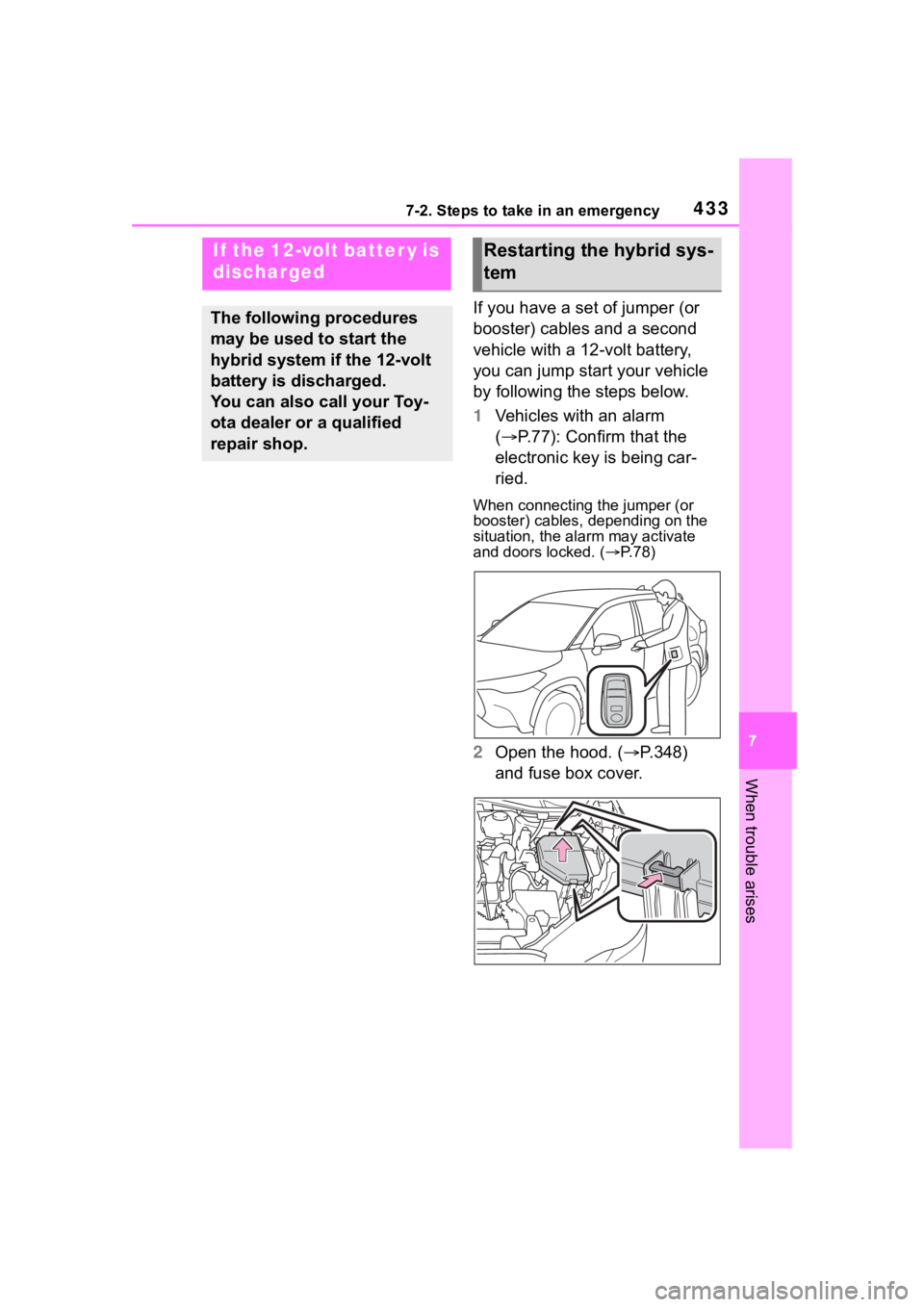
4337-2. Steps to take in an emergency
7
When trouble arises
If you have a set of jumper (or
booster) cables and a second
vehicle with a 12-volt battery,
you can jump start your vehicle
by following the steps below.
1Vehicles with an alarm
( P.77): Confirm that the
electronic key is being car-
ried.
When connecting the jumper (or
booster) cables, depending on the
situation, the alarm may activate
and doors locked. ( P. 7 8 )
2 Open the hood. ( P.348)
and fuse box cover.
If the 12-volt batter y is
discharged
The following procedures
may be used to start the
hybrid system if the 12-volt
battery is discharged.
You can also call your Toy-
ota dealer or a qualified
repair shop.
Restarting the hybrid sys-
tem
Page 435 of 516
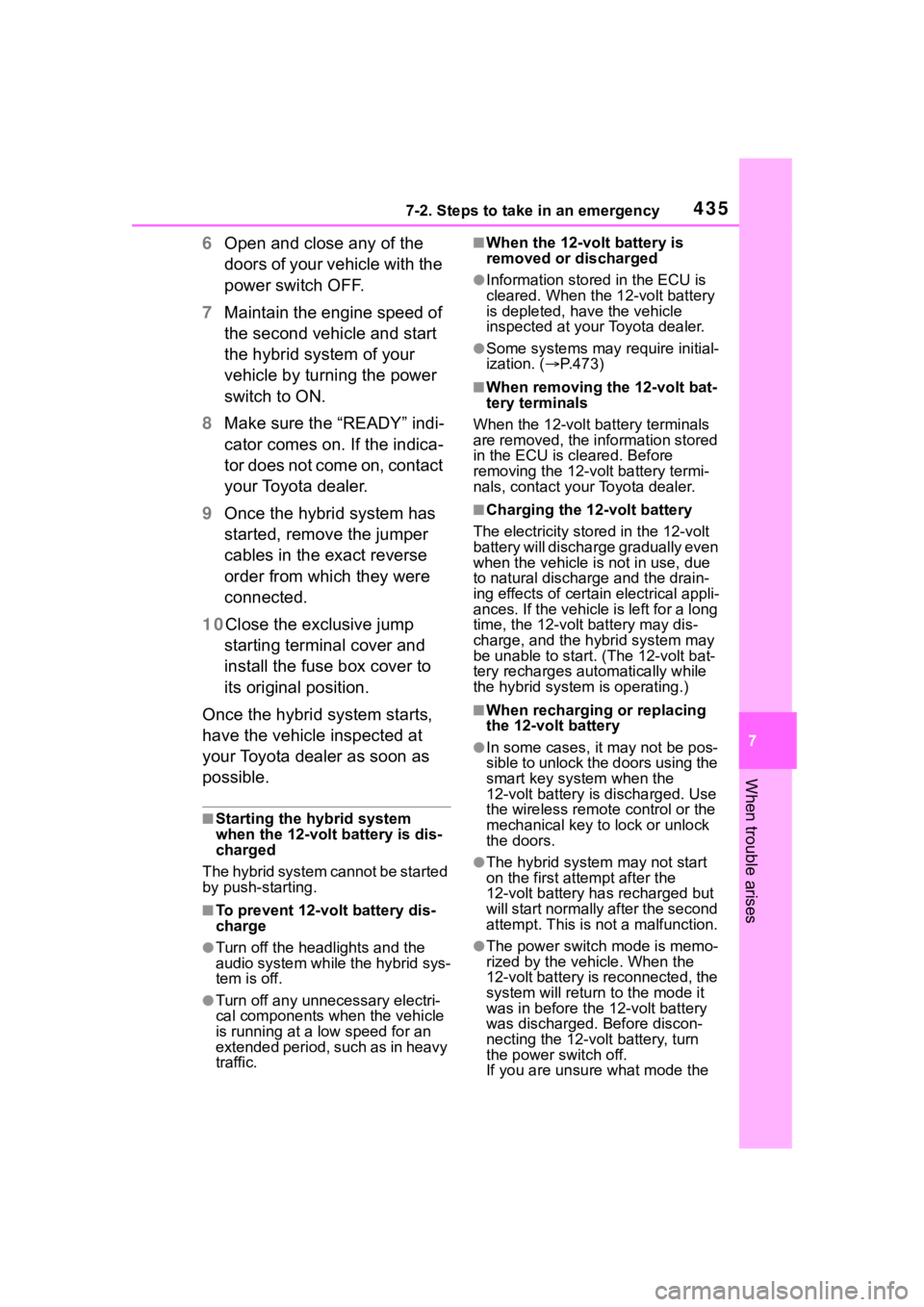
4357-2. Steps to take in an emergency
7
When trouble arises
6Open and close any of the
doors of your vehicle with the
power switch OFF.
7 Maintain the engine speed of
the second vehicle and start
the hybrid system of your
vehicle by turning the power
switch to ON.
8 Make sure the “READY” indi-
cator comes on. If the indica-
tor does not come on, contact
your Toyota dealer.
9 Once the hybrid system has
started, remove the jumper
cables in the exact reverse
order from which they were
connected.
10 Close the exclusive jump
starting terminal cover and
install the fuse box cover to
its original position.
Once the hybrid system starts,
have the vehicle inspected at
your Toyota dealer as soon as
possible.
■Starting the hybrid system
when the 12-volt battery is dis-
charged
The hybrid system cannot be started
by push-starting.
■To prevent 12-volt battery dis-
charge
●Turn off the headlights and the
audio system while the hybrid sys-
tem is off.
●Turn off any unnecessary electri-
cal components when the vehicle
is running at a low speed for an
extended period, such as in heavy
traffic.
■When the 12-volt battery is
removed or discharged
●Information stored in the ECU is
cleared. When the 12-volt battery
is depleted, have the vehicle
inspected at your Toyota dealer.
●Some systems may require initial-
ization. ( P.473)
■When removing the 12-volt bat-
tery terminals
When the 12-volt battery terminals
are removed, the information stored
in the ECU is cleared. Before
removing the 12-vo lt battery termi-
nals, contact you r Toyota dealer.
■Charging the 12-volt battery
The electricity stored in the 12-volt
battery will discha rge gradually even
when the vehicle i s not in use, due
to natural dischar ge and the drain-
ing effects of certain electrical appli-
ances. If the vehicle is left for a long
time, the 12-volt battery may dis-
charge, and the hybrid system may
be unable to start. (The 12-volt bat-
tery recharges automatically while
the hybrid system is operating.)
■When recharging or replacing
the 12-volt battery
●In some cases, it may not be pos-
sible to unlock the doors using the
smart key system when the
12-volt battery is discharged. Use
the wireless remote control or the
mechanical key to lock or unlock
the doors.
●The hybrid syste m may not start
on the first attempt after the
12-volt battery has recharged but
will start normally after the second
attempt. This is not a malfunction.
●The power switch mode is memo-
rized by the vehicle. When the
12-volt battery is reconnected, the
system will return to the mode it
was in before the 12-volt battery
was discharged. Before discon-
necting the 12-volt battery, turn
the power switch off.
If you are unsure what mode the
Page 493 of 516
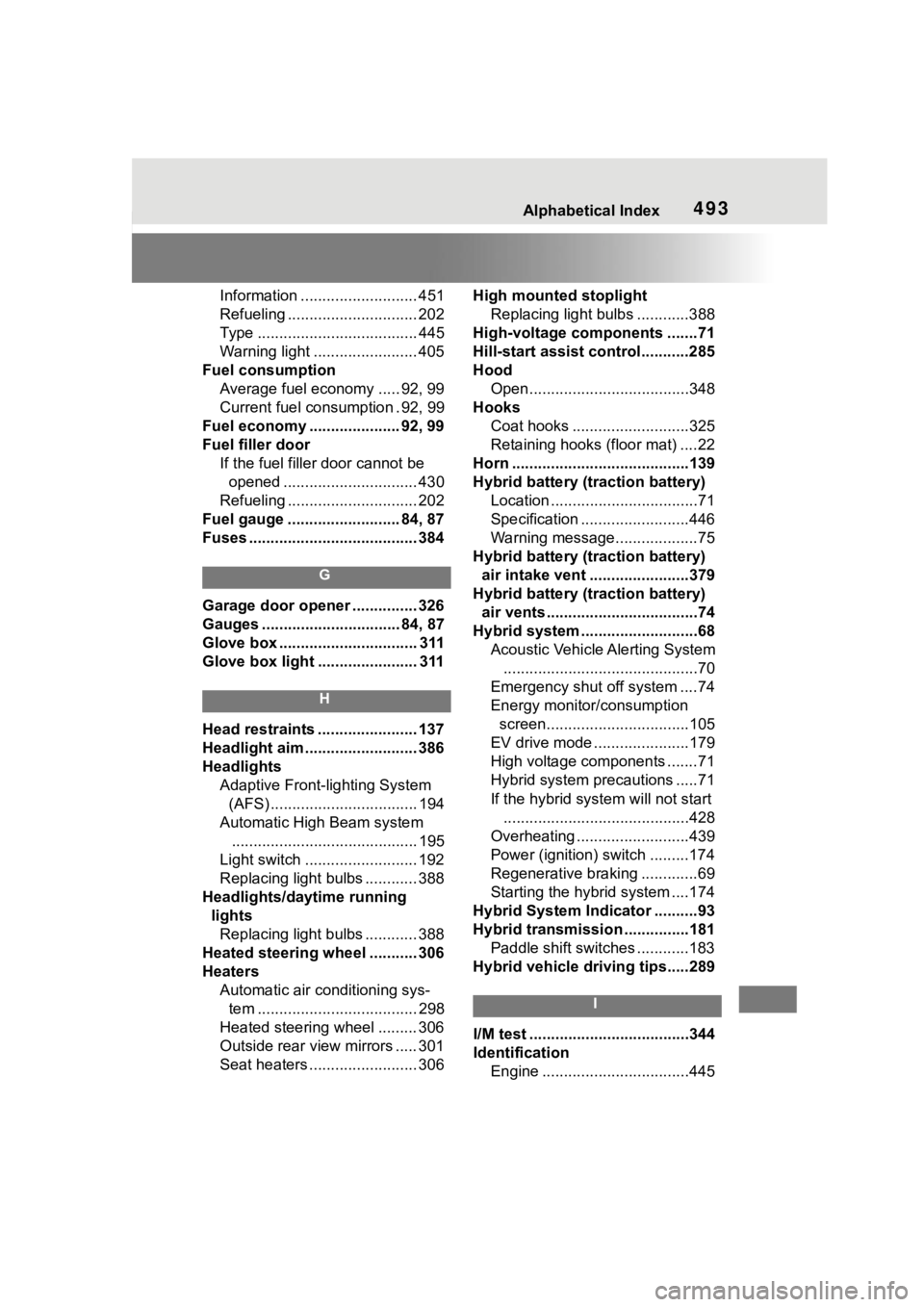
493Alphabetical Index
Information ........................... 451
Refueling .............................. 202
Type ..................................... 445
Warning light ........................ 405
Fuel consumption Average fuel economy ..... 92, 99
Current fuel consumption . 92, 99
Fuel economy ......... ............ 92, 99
Fuel filler door If the fuel filler door cannot be opened ............................... 430
Refueling .............................. 202
Fuel gauge .......................... 84, 87
Fuses ....................................... 384
G
Garage door opener ............... 326
Gauges ................................ 84, 87
Glove box ................................ 311
Glove box light ....................... 311
H
Head restraints ....................... 137
Headlight aim .......................... 386
Headlights Adaptive Front-lighting System (AFS) .................................. 194
Automatic High Beam system ........................................... 195
Light switch .......................... 192
Replacing light bulbs ............ 388
Headlights/daytime running lightsReplacing light bulbs ............ 388
Heated steering wheel ........... 306
Heaters Automatic air conditioning sys-tem ..................................... 298
Heated steering wheel ......... 306
Outside rear view mirrors ..... 301
Seat heaters ......................... 306 High mounted stoplight
Replacing light bulbs ............388
High-voltage components .......71
Hill-start assist control...........285
Hood Open.....................................348
Hooks Coat hooks ...........................325
Retaining hooks (floor mat) ....22
Horn .........................................139
Hybrid battery (traction battery) Location ..................................71
Specification .........................446
Warning message...................75
Hybrid battery (traction battery) air intake vent .......................379
Hybrid battery (traction battery) air vents ...................................74
Hybrid system .... .......................68
Acoustic Vehicle Alerting System .............................................70
Emergency shut off system ....74
Energy monitor/consumption screen.................................105
EV drive mode ......................179
High voltage components .......71
Hybrid system precautions .....71
If the hybrid sys tem will not start
...........................................428
Overheating ..........................439
Power (ignition) switch .........174
Regenerative braking .............69
Starting the hybrid system ....174
Hybrid System Indicator ..........93
Hybrid transmissio n ...............181
Paddle shift switches ............183
Hybrid vehicle dri ving tips.....289
I
I/M test .....................................344
Identification
Engine ..................................445